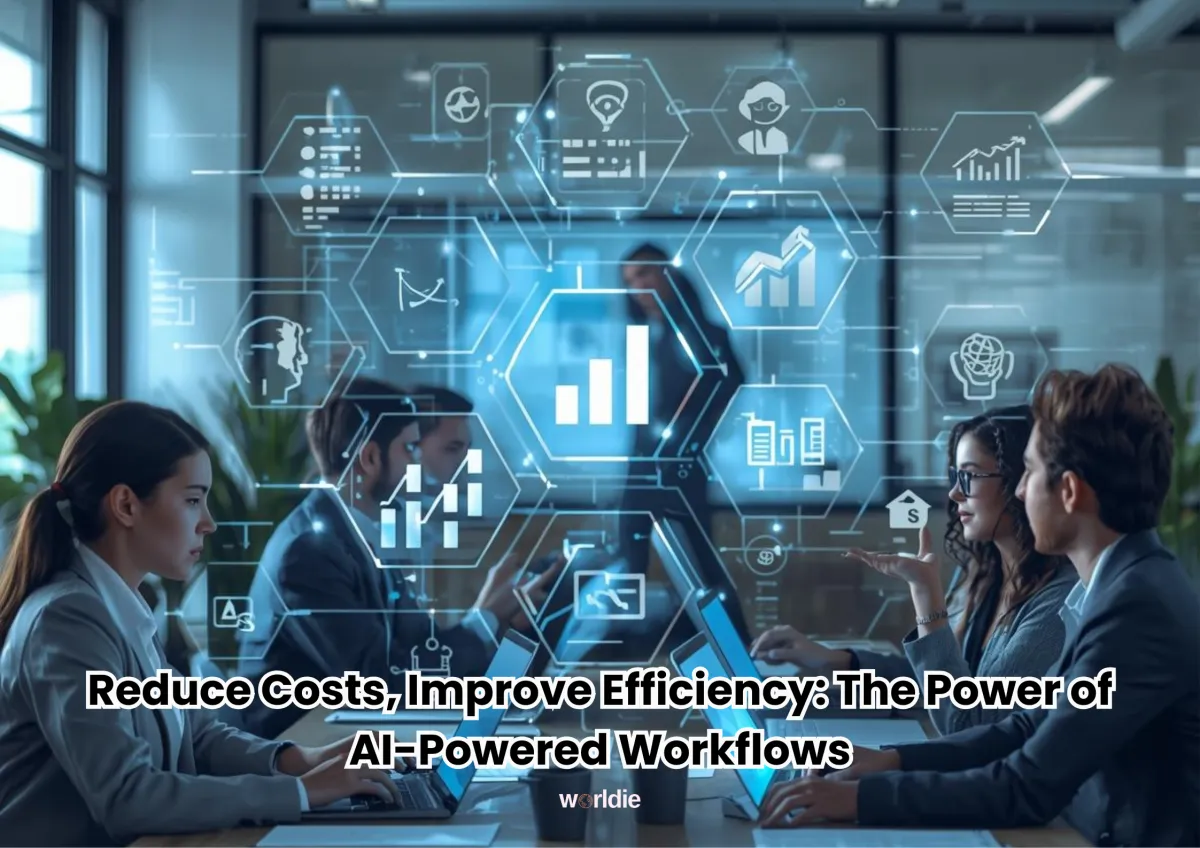
Reduce Costs, Improve Efficiency: The Power of AI-Powered Workflows
AI-powered workflows that reduce costs and improve efficiency are redefining how businesses operate, scale, and grow. Traditional systems are often rigid, human-dependent, and limited by manual bottlenecks. Artificial intelligence introduces an entirely new layer of automation that not only streamlines operations but also creates intelligent systems capable of self-optimization and decision-making. For businesses focused on scaling sustainably, AI-powered workflows represent a strategic shift — one that transforms efficiency from a target into a continuous cycle of improvement.
What AI-Powered Workflows Really Mean
AI-powered workflows combine automation with machine learning, allowing systems to make data-driven decisions without constant human input. These workflows integrate predictive analytics, natural language processing, and intelligent process automation to identify inefficiencies and dynamically adapt. Rather than automating tasks in isolation, they connect entire processes across marketing, sales, and operations — creating a single, intelligent operational engine that evolves with business goals.
When implemented correctly, AI workflows become the invisible backbone of a business. They analyze customer behavior, forecast demand, optimize logistics, and even automate reporting — not by replacing people but by amplifying their capabilities. In a sense, AI workflows turn operational friction into growth momentum.
Why Traditional Workflows Fail
Most companies operate through fragmented systems. Marketing uses one platform, sales rely on another, and operations depend on outdated spreadsheets or legacy tools. These silos cause delays, miscommunication, and inefficiencies that compound over time. Employees end up spending more time transferring data between systems than analyzing it. Leadership teams lack a real-time view of performance, forcing decisions based on incomplete or outdated insights.
AI resolves this disconnection. Instead of separate processes, it creates a unified ecosystem where data flows freely, insights are automatically generated, and repetitive actions are executed autonomously. This integration is where operational efficiency truly begins.
How AI Reduces Costs While Driving Efficiency
AI reduces costs not by cutting corners but by removing waste — in time, energy, and human effort. When systems predict outcomes, optimize resource use, and automate manual labor, the business operates with precision.
A sales team, for example, spends less time qualifying leads because AI automatically identifies the most promising ones. Marketing can focus on creativity rather than reporting, as campaign data updates in real time. Operations can reduce inventory costs because AI predicts demand fluctuations weeks in advance. Each improvement might seem small, but together they compound into major cost savings and improved profit margins.
Common Inefficiencies That AI Fixes
Manual reporting consumes valuable hours each week and often produces outdated information.
Customer data is scattered across multiple platforms, creating inconsistencies that lead to poor decision-making.
Teams spend days managing repetitive tasks like invoice approvals, scheduling, or ticket routing.
AI eliminates these inefficiencies by continuously learning from patterns and adapting workflows automatically. Tasks that once required human review can now be handled intelligently, freeing people to focus on creativity, innovation, and strategy.
Industry Use Cases of AI-Powered Workflows
AI-powered workflows are not exclusive to one industry. They are reshaping how companies in every sector operate.
In manufacturing, AI predicts machine maintenance needs before breakdowns occur.
In retail, it optimizes pricing and stock levels based on real-time consumer demand.
In healthcare, it automates appointment scheduling, medical record processing, and even clinical predictions.
In professional services, AI workflows manage client communications, proposal generation, and billing — allowing teams to scale without burnout.
Across all industries, the outcome is consistent: fewer errors, faster execution, and more predictable outcomes.
The Worldie AI Approach: Design → Build → Release
Worldie AI takes a systematic approach to workflow automation — one grounded in design thinking and technical excellence. Every engagement begins with an in-depth assessment of a company’s processes, identifying where automation and intelligence can create the highest impact.
The design phase maps every workflow, uncovering inefficiencies that limit growth.
The build phase focuses on creating intelligent systems that align with operational realities.
The release phase ensures seamless deployment, continuous monitoring, and optimization.
Worldie AI doesn’t just deploy technology; it builds infrastructure for long-term scalability. Each solution is custom-built to integrate with existing systems and evolve as the business grows.
Bridging Technology and Human Collaboration
AI workflows thrive when they are built to complement human teams rather than replace them. The goal is not to automate people out of the equation but to enable them to work smarter and faster. AI can handle the repetitive and analytical layers, while human creativity and strategy guide direction. This combination transforms the workplace into a space of innovation rather than routine.
The Challenge of Data and Integration
Many AI projects fail because of poor data management. Systems are only as intelligent as the data they are trained on. Disconnected databases, inconsistent formats, and missing records limit what AI can achieve. Integration across departments is another major hurdle — if marketing, sales, and operations operate in silos, AI workflows cannot deliver full impact.
Worldie AI addresses this by building unified data foundations. By aligning data architecture with business objectives, AI systems gain access to clean, real-time information — ensuring that predictions and decisions are reliable and actionable.
How to Measure the ROI of AI-Powered Workflows
Return on investment from AI automation isn’t measured only by cost savings. True ROI comes from scalability, speed, and accuracy. Businesses experience better forecasting, shorter sales cycles, improved customer retention, and optimized resource allocation. Metrics often include time saved per task, error reduction rates, and customer satisfaction improvements.
By tracking both operational and financial performance, leadership can directly connect automation initiatives to revenue growth. Worldie AI helps companies set these benchmarks early and monitor them continuously.
Scaling with AI: From Pilot Projects to Full Integration
Many companies start small — perhaps automating a single workflow in marketing or customer support. Over time, the benefits become undeniable, and expansion follows. The key is not just to deploy more automation but to ensure that each system communicates with the others.
When AI workflows scale cohesively, every department benefits. Data moves fluidly, insights compound, and decision-making accelerates. Businesses that take this incremental but strategic approach often see the most sustainable results.
Real-World Transformations Powered by AI
A logistics company reduced operational costs by 35% after implementing predictive routing systems powered by AI.
A B2B SaaS firm cut lead qualification time in half by deploying an AI workflow that analyzed customer engagement data across multiple channels.
A retail group increased customer lifetime value by 20% after AI workflows automated personalized marketing campaigns in real time.
These transformations aren’t theoretical — they are the direct outcome of aligning automation with strategy.
The Future of Workflows: Adaptive Intelligence
Traditional automation follows rules; AI-powered automation learns. As machine learning models improve, workflows will become fully adaptive — capable of responding to market trends, operational challenges, and customer behavior in real time. The businesses that invest now in structured AI workflows will be the ones operating at peak efficiency tomorrow.
Why Partner with Worldie AI
Worldie AI combines technical precision with business insight. The team’s expertise lies not only in building intelligent systems but also in ensuring that they directly enhance profitability and scalability. Each project is guided by a clear strategy — transforming workflows into measurable competitive advantages.
Partnering with Worldie AI means unlocking a future where every process, decision, and customer interaction becomes smarter, faster, and more valuable.
FAQs
1. What types of business processes can be automated with AI?
Almost any process involving repetitive, data-driven tasks can be automated. This includes lead qualification, invoice management, marketing campaign analysis, customer support ticket routing, inventory forecasting, and performance reporting. The best candidates for automation are processes that occur frequently and rely on structured data.
2. How long does it take to implement AI-powered workflows?
Implementation time varies depending on system complexity and data readiness. Smaller projects can be completed within weeks, while large-scale integrations across departments might take several months. A structured approach, like the one used by Worldie AI, ensures efficiency by addressing design, testing, and deployment in parallel.
3. How does AI help reduce operational costs?
AI reduces costs by eliminating inefficiencies such as manual labor, duplicate work, and human errors. It also improves forecasting accuracy, preventing waste in marketing spend, logistics, and inventory. Over time, the automation of decision-making processes leads to faster responses and higher profitability.
4. What are the biggest risks in automating with AI?
The main risks involve poor data quality, lack of integration between systems, and resistance to change among teams. These challenges can be mitigated through proper planning, structured data management, and gradual implementation that prioritizes collaboration between technology and people.
5. Why should a business choose Worldie AI for automation?
Worldie AI stands out for its end-to-end approach — from system design to deployment and continuous optimization. The company’s expertise ensures that automation is not only technically sound but strategically aligned with business goals. Worldie AI doesn’t just build AI systems; it engineers revenue transformation.

